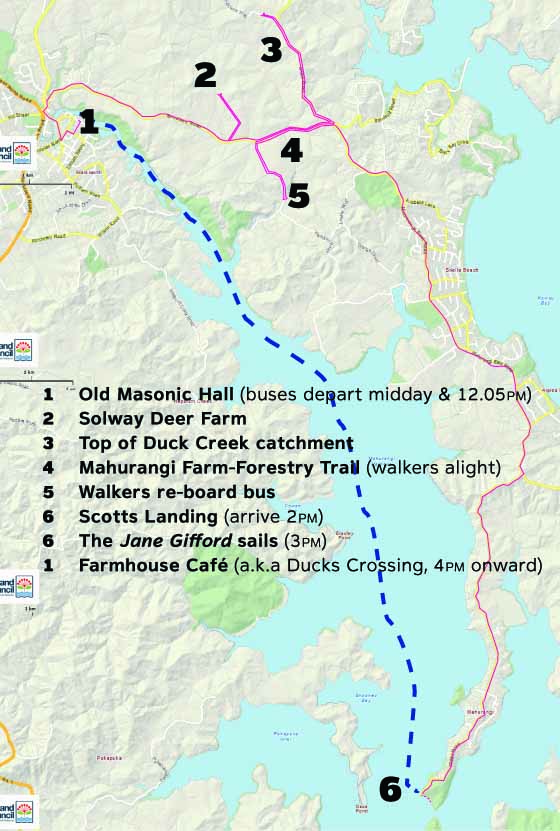True test for Mahurangi Action is its plan for the next 40 years

En Route: Sunday’s excursion will highlight the sorts of good works the Mahurangi catchment will need to see a lot more of if it is to resist the worst ravages of anthropogenic global warming, over the next 40 years. Route map for Sunday’s Mahurangi Action Plan 10th anniversary celebration, and Mahurangi Action’s 40th. image Mahurangi Magazine
In 1974, the town was planning to replace its appallingly inadequate riverside municipal septic tank.
Warkworth’s council was finally facing up to the need to treat its wastewater, after decades of wilful neglect of the issue, which, after heavy rainfall, routinely saw raw sewage flowing in town’s streets, and the river stained a disgusting reddish brown.
But rather than be universally applauded, strong concerns were raised that the wastewater treatment planned by the town council would be inadequate to protect neither the recreational use of the river, nor the marine farming use of the harbour downstream. It was the proximate issue that caused Mahurangi Action to be formed, as Friends of the Mahurangi, on 17 December that year.
The more fundamental driver, at least for its founding chairman, John Male, was the protection of the Mahurangi harbourscape from rampant coastal subdivision; he was also exercised by the proliferation of oyster farm leases, beyond a moratorium he claimed had been agreed to, during his single term as a Rodney County councillor.
But it was world peace and the avoidance of global thermonuclear war, rather than landscape or environmental issues that primarily drove John Male. He’d retired early from his role in New York with the United Nations to return to his birth country, after what must have seemed an eternity, including as it did, his service as a war poet, in World War II. John and others formed the New Zealand Foundation for Peace Studies, and he riled the Returned Services Association of a Warkworth Anzac Day parade, laying wreaths dedicated:
To the dead and dying on both sides of the Vietnam War
Four decades on, the threat of an all-out nuclear war has receded. Yet some 41 million civilian and military lives have been lost to the, mostly Third-World, wars waged since World War II—two and a half times as many as perished in the First World War. But with anthropogenic global warming beginning to bite, and today’s population of seven billion and gambling on surviving with little in the way organised grain storage—neoliberal dictates that the market obviates the need for physical silos—will likely suffer a far a greater death toll in the next 40 years than the estimated 142 million lives lost to war since 1914.
Given that wealthy countries can be expected to insulate all but the poorest of their populations from the worst of the privations of global warming, and given its temperate location, most New Zealanders will possibly fare better than many, born in the wrong place at the wrong time. But whereas John Male’s bête noire posed no guaranteed menace to the Mahurangi, warming will wreak havoc on the harbour’s hillsides, as extreme rainfall events come both more extreme, and more frequent, and as sea-level rise gnaws into its all too tender coastline.
It behoves Mahurangi Action, in its 41st year, to begin drafting a 40-year plan, with emphasis on how the catchment can be rendered more resilient, to resist the stronger storms and ever-higher king tides that are the harbour’s, and humanity’s now-inescapable future.
But such planning can be a joyous business, and can emphasise the wondrous possibilities of a landscape crisscrossed with walking trails, and graced with streams and wetlands cloaked, once again, in indigenous forest and ringing with birdsong…
…and a harbour with an ever-healthier resident snapper population, and mullet, and flounder.
